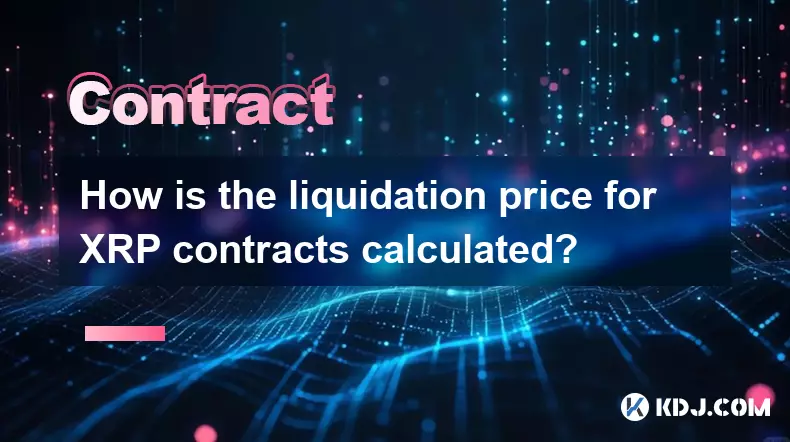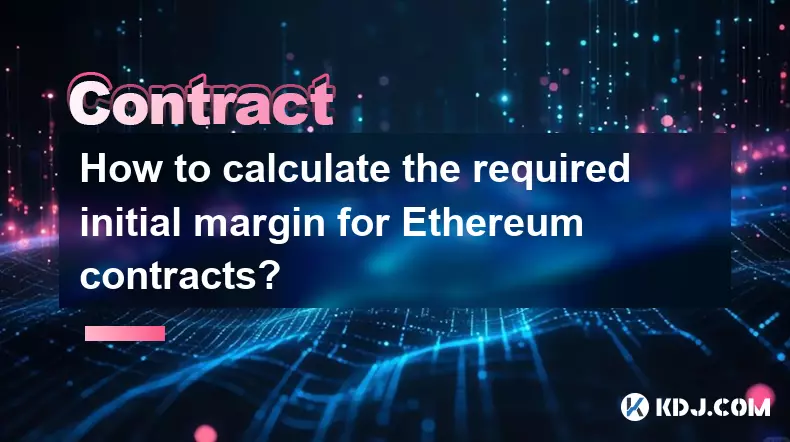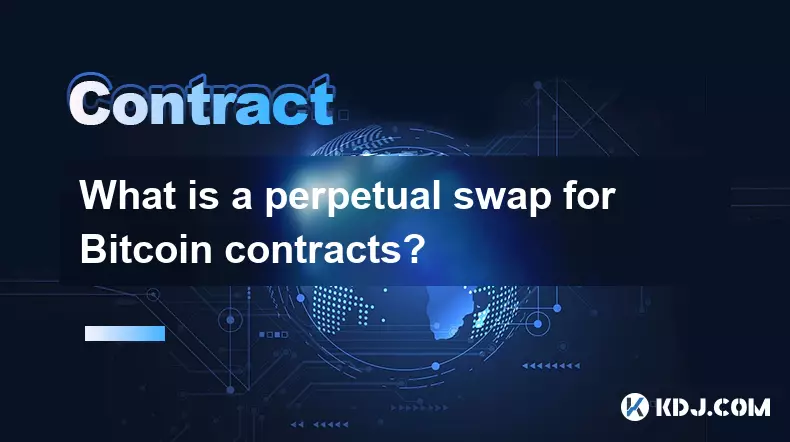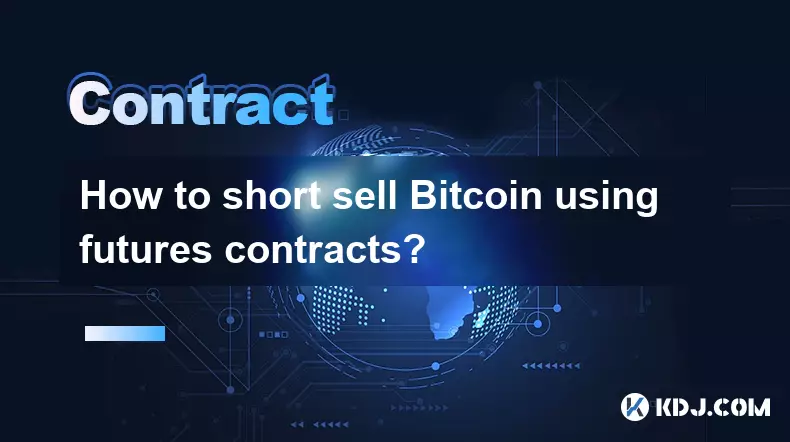-
 bitcoin
bitcoin $118548.520763 USD
3.67% -
 ethereum
ethereum $4352.564943 USD
4.79% -
 xrp
xrp $2.964058 USD
4.22% -
 tether
tether $1.000565 USD
0.05% -
 bnb
bnb $1028.372955 USD
1.46% -
 solana
solana $221.373507 USD
6.00% -
 usd-coin
usd-coin $0.999933 USD
0.02% -
 dogecoin
dogecoin $0.248633 USD
6.85% -
 tron
tron $0.341444 USD
2.38% -
 cardano
cardano $0.852946 USD
5.82% -
 hyperliquid
hyperliquid $47.869306 USD
6.15% -
 chainlink
chainlink $22.561476 USD
6.01% -
 ethena-usde
ethena-usde $1.001258 USD
0.05% -
 avalanche
avalanche $30.660000 USD
2.06% -
 stellar
stellar $0.400917 USD
9.76%
How is the liquidation price for XRP contracts calculated?
The liquidation price in XRP futures depends on leverage, margin, funding rates, and mark price, varying across exchanges due to different risk models.
Sep 29, 2025 at 03:55 pm

Liquidation Price Mechanics in XRP Futures Trading
1. The liquidation price for XRP contracts is determined by the point at which a trader’s margin balance falls below the required maintenance margin. This occurs when losses on a leveraged position erode the collateral supporting the trade. Exchanges monitor this level continuously and trigger liquidation once equity drops too low.
2. For long positions, the liquidation price is generally lower than the entry price, especially as leverage increases. Conversely, short positions face liquidation when the price rises above a critical threshold. The exact formula depends on the initial margin, leverage used, fees, and funding rates applied during the contract’s lifespan.
3. Most derivatives exchanges use a mark price rather than the last traded price to calculate liquidations. This prevents manipulation and ensures stability. The mark price is typically derived from the spot market price with adjustments based on fair premium indices, reducing the chance of unfair liquidations during volatility spikes.
4. Fees and funding payments are factored into the liquidation engine. Long positions pay funding rates in bullish markets, increasing their cost basis over time. Shorts may receive or pay depending on rate direction. These periodic transfers influence the effective break-even and thus impact the liquidation level.
5. Different platforms apply distinct risk engines, meaning the same XRP position might have varying liquidation prices across exchanges. Traders must review each platform's methodology, including whether insurance funds or auto-deleveraging systems are used post-liquidation.
Key Variables Influencing XRP Liquidation Levels
1. Leverage plays a central role. A 10x leveraged XRP/USDT contract requires only 10% margin, making it more susceptible to price swings compared to 2x leverage. Higher leverage shrinks the buffer between entry and liquidation price.
2. Position size directly affects the margin utilization rate. Larger positions consume more of the available balance, accelerating the approach to the maintenance threshold. Risk management tools like partial closures can delay or prevent full liquidation.
3. Maintenance margin requirements vary by exchange and contract type. For instance, some platforms set it at 0.5% of notional value for XRP futures, while others adjust dynamically based on volatility and open interest.4. Funding rate accruals, though small per interval, accumulate over days. In highly skewed markets where longs dominate, shorts receive substantial funding—this inflow slightly raises their breakeven but does not eliminate directional risk exposure.
5. The difference between entry price and mark price impacts unrealized PnL calculations. If the mark price deviates significantly due to basis widening, even profitable-looking trades on entry can face liquidation if collateral erosion crosses thresholds.
Practical Examples of XRP Contract Liquidation Scenarios
1. Suppose a trader opens a long position on XRP/USD perpetual futures at $0.50 with 20x leverage. With a $1,000 margin, they control $20,000 worth of XRP (40,000 units). Assuming a maintenance margin of 0.5%, the system allows equity to drop to $100 before initiating liquidation.
2. Using standard formulas, the estimated liquidation price would be approximately $0.476, assuming no fees or funding costs. This reflects a ~4.8% drop from entry. Any further decline pushes the position below the safety threshold.
3. In a short scenario at the same entry, liquidation occurs if XRP rises toward $0.525, again influenced by leverage and margin buffers. Short liquidations often happen faster during pump events driven by news or whale activity.
4. During high volatility—such as regulatory announcements about Ripple Labs—price gaps can lead to immediate liquidations even if stop-loss orders are placed. The reliance on mark price helps, but extreme moves may still result in clawbacks or socialized losses.5. Some traders use isolated margin mode to limit risk to a specific amount. In this case, liquidation wipes only the allocated margin. Cross-margin modes pull from total balance, potentially preserving the position longer but risking broader account drawdown.
Frequently Asked Questions
What triggers an XRP futures liquidation?A liquidation is triggered when the equity in a leveraged position falls below the maintenance margin requirement. This usually happens due to adverse price movement reducing the value of the collateral backing the trade.
Can I avoid liquidation on my XRP contract?Yes, by reducing leverage, adding more margin manually, or closing part of the position to free up equity. Setting realistic stop-loss levels and monitoring funding rates also help maintain control over risk exposure.
Does the liquidation price change over time?Yes, it fluctuates based on real-time mark price, accrued funding payments, and changes in maintenance margin rules. It is not fixed after entry and must be monitored throughout the trade duration.
Why do some XRP positions get liquidated even when the market seems stable?This can occur due to temporary dislocations between index and mark prices, hidden slippage in thin order books, or delayed updates in margin calculations during low-liquidity periods.
Disclaimer:info@kdj.com
The information provided is not trading advice. kdj.com does not assume any responsibility for any investments made based on the information provided in this article. Cryptocurrencies are highly volatile and it is highly recommended that you invest with caution after thorough research!
If you believe that the content used on this website infringes your copyright, please contact us immediately (info@kdj.com) and we will delete it promptly.
- BlockDAG, DOGE, HYPE Sponsorship: Crypto Trends Shaping 2025
- 2025-10-01 00:25:13
- Deutsche Börse and Circle: A StableCoin Adoption Powerhouse in Europe
- 2025-10-01 00:25:13
- BlockDAG's Presale Buzz: Is It the Crypto to Watch in October 2025?
- 2025-10-01 00:30:13
- Bitcoin, Crypto, and IQ: When Genius Meets Digital Gold?
- 2025-10-01 00:30:13
- Stablecoins, American Innovation, and Wallet Tokens: The Next Frontier
- 2025-10-01 00:35:12
- NBU, Coins, and Crypto in Ukraine: A New Yorker's Take
- 2025-10-01 00:45:14
Related knowledge

What is the difference between futures and perpetual contracts for Bitcoin?
Oct 02,2025 at 11:54pm
Understanding Bitcoin Futures Contracts1. Bitcoin futures are derivative instruments that allow traders to speculate on the future price of Bitcoin at...

What is the maintenance margin for Bitcoin contracts?
Oct 02,2025 at 01:36am
Decentralized Exchanges Gain Momentum in 20241. Decentralized exchanges (DEXs) have seen a significant rise in trading volume, surpassing centralized ...

How to calculate the required initial margin for Ethereum contracts?
Oct 01,2025 at 06:01am
Understanding Initial Margin in Ethereum Futures1. The initial margin for Ethereum futures contracts represents the minimum amount of capital a trader...

What is a perpetual swap for Bitcoin contracts?
Oct 01,2025 at 08:18am
Understanding Perpetual Swaps in Bitcoin Trading1. A perpetual swap is a type of derivative contract that allows traders to speculate on the price of ...

What is the best platform for trading SOL contracts?
Oct 01,2025 at 06:36am
Understanding the Role of Decentralized Exchanges in Modern Crypto Trading1. Decentralized exchanges (DEXs) have reshaped how traders interact with di...

How to short sell Bitcoin using futures contracts?
Oct 01,2025 at 02:54am
Understanding the Role of Decentralized Exchanges in Crypto Trading1. Decentralized exchanges (DEXs) have become a cornerstone of the cryptocurrency e...

What is the difference between futures and perpetual contracts for Bitcoin?
Oct 02,2025 at 11:54pm
Understanding Bitcoin Futures Contracts1. Bitcoin futures are derivative instruments that allow traders to speculate on the future price of Bitcoin at...

What is the maintenance margin for Bitcoin contracts?
Oct 02,2025 at 01:36am
Decentralized Exchanges Gain Momentum in 20241. Decentralized exchanges (DEXs) have seen a significant rise in trading volume, surpassing centralized ...

How to calculate the required initial margin for Ethereum contracts?
Oct 01,2025 at 06:01am
Understanding Initial Margin in Ethereum Futures1. The initial margin for Ethereum futures contracts represents the minimum amount of capital a trader...

What is a perpetual swap for Bitcoin contracts?
Oct 01,2025 at 08:18am
Understanding Perpetual Swaps in Bitcoin Trading1. A perpetual swap is a type of derivative contract that allows traders to speculate on the price of ...

What is the best platform for trading SOL contracts?
Oct 01,2025 at 06:36am
Understanding the Role of Decentralized Exchanges in Modern Crypto Trading1. Decentralized exchanges (DEXs) have reshaped how traders interact with di...

How to short sell Bitcoin using futures contracts?
Oct 01,2025 at 02:54am
Understanding the Role of Decentralized Exchanges in Crypto Trading1. Decentralized exchanges (DEXs) have become a cornerstone of the cryptocurrency e...
See all articles










































































